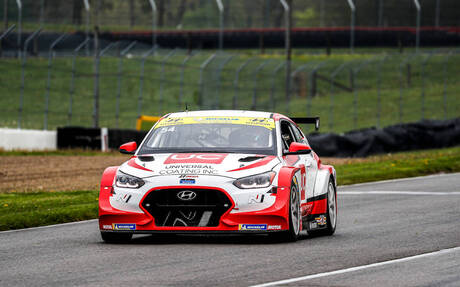Robert Wickens Back at the Wheel After 2018 Crash
A little less than three years ago, Canadian IndyCar driver Robert Wickens was involved in a terrible accident while participating in the ABC Supply 500 at Pocono Raceway on August 19, 2018. The catastrophic event resulted in a series of serious injuries for Wickens, including a thoracic spinal fracture, spinal cord injury, as well as fractures to the neck, legs, and arms. The event left him paralyzed from the chest down and almost ended his racing career.
Yesterday, this up-and-coming driver and 2018 Indy Car Rookie of the Year showed up in the Bryan Herta Autosport’s paddock at Mid-Ohio during an all-Hyundai test day to take the wheel of the #54 Hyundai Veloster N TCR, a car that has been specifically prepared for driver Michael Johnson, also paraplegic.
- Also: 2021 Hyundai Veloster N Returns, Base Veloster Models Axed in Canada
- Also: Honda Indy Toronto Removed From 2021 Calendar
The event attracted a lot of attention, but for Wickens, it constituted a giant leap forward for his ongoing recovery. IMSA, Bryan Herta Autosport and Hyundai gave us the opportunity to ask Wickens a few questions regarding this informal comeback.

Inside the Hyundai Veloster N TCR
“How does it feel to be back?” is the first question we, and everyone in the automotive/racing media asked Wickens when the mic turned on. And while some might have expected a really emotional answer, Wickens answered it like a true racer. “When I saw the car and sat in the seat, I told myself, game on!”
Obviously, the #54 Hyundai Veloster N TCR he took command of isn’t built like the other ones on the track—let alone any of the cars Wickens had been competing in before his accident. To top things off, the Hyundai Veloster N is front-wheel-drive. But the Canadian driver seemed impressed by the overall performance of the car, going as far as mentioning that if he didn’t know it was front wheel drive, it would have taken a while for him to figure it out. That says a lot about the car itself.
Technically, every component in the cockpit located below the waist is useless to him, thus everything revolves around the steering wheel–which has become a multifunctional tool. The hand controls consist of two custom metal rings attached to the steering wheel, which are connected to the brake pedal and accelerator by a series of rods and joints. The driver can accelerate and brake by giving input to these rings. The steering wheel is also fitted with a set of paddle shifters.
“There’s no textbook that comes with this car, and it wasn't second nature for me at the beginning,” said Wickens about his first impression on the track. “I applaud how Johnson has been so successful in this car,” he added.

Looking to the future
“I’m appreciative of the opportunity Hyundai and Bryan Herta have provided, and a big thanks to Michael Johnson for this collaboration. It’s been a journey getting here and the experience on track today was incredibly rewarding. Working with the team, dialing the car in, gaining speed and improving the handling–it was awesome. The Veloster N TCR was a blast to drive. Once I got comfortable with the car, I began to understand what I need for my own accessibility to move forward.”
So what’s next for Robert Wickens? Training, support, a strong disciplined recovery and a few miracles brought him where he is now. Wickens is very keen to get back into professional racing. But there are many challenges ahead.
When asked about how he foresaw the next steps, Wickens had a living the moment philosophy “It was the first time in a very long time, I think since 2010, that I could spend a day on the track with zero-pressure to perform, from fans and sponsors. It was just me and the car. And as the day ended, I started to realize and appreciate how that was a critical step towards my recovery.”
